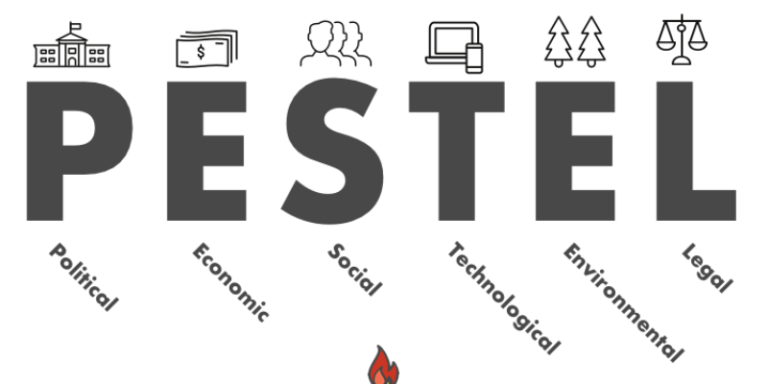In an increasingly globalised and competitive world, organisations must develop a robust strategy to survive and thrive. One of the most effective ways to inform strategic decisions is by conducting a thorough analysis of the external environment. The external environment refers to all the factors outside an organisation that can impact its performance, opportunities, and threats. It includes elements such as political changes, economic conditions, societal trends, technological developments, environmental issues, and legal regulations (Barney & Hesterly, 2019). Understanding these external factors allows organisations to remain agile and adaptive, thus enhancing their strategic positioning in the market. This essay explores the importance of external environment analysis, and the tools used to conduct it, such as SWOT and PESTEL analysis, providing an in-depth understanding of how these approaches help organisations navigate the challenges and opportunities they face.
The Importance of External Environment Analysis
Conducting an external environment analysis is essential for organisations to make informed strategic decisions. It enables organisations to identify opportunities and threats in the marketplace, thereby guiding decision-makers in shaping competitive strategies. Organisations that fail to conduct a thorough external analysis risk being blindsided by unforeseen changes in the market, leading to strategic misalignment and potential failure (Grant, 2019).
External environment analysis contributes to understanding market trends and customer needs, both of which are crucial for sustainable growth. It helps identify shifts in consumer preferences, technological advancements, and regulatory changes that can either provide growth opportunities or pose challenges (Johnson et al., 2017). For instance, when smartphones began dominating the tech market, companies like Nokia that failed to adapt to these technological shifts faced significant losses, while competitors like Apple and Samsung capitalised on these opportunities.
Furthermore, a well-executed external environment analysis allows organisations to anticipate changes, minimise risks, and take proactive steps to stay ahead of their competitors. In industries where external factors are unpredictable, such as the tech or automotive industry, a comprehensive analysis of the external environment is indispensable.
Tools for External Environment Analysis
Two of the most commonly used tools for analysing the external environment are SWOT analysis and PESTEL analysis. Both tools help managers understand different facets of external factors that affect an organisation’s strategic choices.
SWOT Analysis
SWOT analysis is a widely used tool that evaluates an organisation’s internal and external factors by categorising them into Strengths, Weaknesses, Opportunities, and Threats. It is a simple yet powerful framework that helps organisations assess both their internal capabilities and external conditions to craft a strategy that leverages strengths and opportunities while mitigating weaknesses and threats (Barney & Hesterly, 2019).
- Strengths refer to the internal characteristics of the organisation that give it an advantage over its competitors, such as a strong brand or efficient supply chain.
- Weaknesses are the internal factors that place the organisation at a disadvantage, such as outdated technology or a poor customer service reputation.
- Opportunities are external conditions that the organisation can exploit to achieve growth, such as new markets or emerging consumer needs.
- Threats are external challenges that could hinder the organisation’s success, such as economic downturns or new competitors entering the market (Johnson et al., 2017).
For example, Apple’s strength lies in its strong brand and innovative product line, which allowed it to take advantage of the opportunity presented by the rise in demand for smartphones and other smart devices. However, the threat posed by increasing competition from Android phone manufacturers remains a constant challenge.
PESTEL Analysis
PESTEL analysis is another crucial tool for analysing the external environment, focusing on six broad categories: Political, Economic, Social, Technological, Environmental, and Legal factors (Grant, 2019). This framework enables organisations to analyse the macro-environmental forces that could impact their performance, providing a deeper understanding of how these forces interact and influence the business landscape.
- Political factors include government policies, political stability, and trade regulations that may affect the organisation. For instance, changes in trade tariffs or government regulations can affect an organisation’s international expansion plans.
- Economic factors such as inflation, interest rates, and currency exchange rates can influence consumer purchasing power and an organisation’s cost structure.
- Social factors reflect societal trends, cultural changes, and consumer behaviours that can shape product demand. For instance, the increasing focus on sustainability has led to a surge in demand for eco-friendly products.
- Technological factors relate to advancements in technology that can impact product development, service delivery, and operational efficiency. The rapid rise of automation and artificial intelligence (AI) offers significant opportunities for improving productivity but also poses threats in terms of workforce redundancy (Grant, 2019).
- Environmental factors include the growing importance of sustainable practices and environmental regulations that organisations must comply with. The rise in environmental consciousness among consumers has driven many organisations to adopt greener practices.
- Legal factors pertain to the laws and regulations governing the industry, such as employment law, health and safety regulations, and data protection laws.
For example, in the automotive industry, Tesla has benefited from the rise in environmental consciousness and governmental support for renewable energy initiatives. However, they must also navigate stringent legal and environmental regulations, both globally and within specific markets (Hitt et al., 2020).
Strategic Implications of External Environment Analysis
Understanding the external environment allows organisations to craft strategies that align with the opportunities and threats in the marketplace. For instance, a firm operating in a high-growth industry with technological advancements, such as telecommunications or biotech, would need to invest heavily in research and development to stay competitive (Barney & Hesterly, 2019). In contrast, companies in more stable or declining industries may focus on cost reduction or market penetration strategies.
In addition, by identifying potential threats early, organisations can mitigate risks or find ways to turn those threats into opportunities. For instance, economic downturns, which are often seen as threats, can provide opportunities for firms that are positioned to offer cost-saving alternatives to consumers (Johnson et al., 2017).
Furthermore, external analysis encourages strategic flexibility, enabling organisations to adjust to market dynamics quickly. It also supports long-term planning by highlighting emerging trends and shifts in the external environment that could impact the organisation in the future (Grant, 2019).
The external environment plays a crucial role in shaping an organisation’s strategy. A thorough analysis of external factors through tools such as SWOT and PESTEL analysis helps organisations anticipate and respond to changes in the market. By understanding the broader context in which they operate, organisations can position themselves to leverage opportunities, mitigate threats, and gain a competitive advantage. In an ever-changing world, external environment analysis is essential for ensuring long-term success and sustainability.
References:
Barney, J.B. and Hesterly, W.S. (2019) Strategic Management and Competitive Advantage: Concepts and Cases. 6th ed. Boston: Pearson.
Grant, R.M. (2019) Contemporary Strategy Analysis. 10th ed. Hoboken, NJ: Wiley.
Hitt, M.A., Ireland, R.D. and Hoskisson, R.E. (2020) Strategic Management: Competitiveness and Globalization. 13th ed. Boston: Cengage.
Johnson, G., Scholes, K. and Whittington, R. (2017) Exploring Corporate Strategy. 11th ed. Harlow: Pearson Education.













